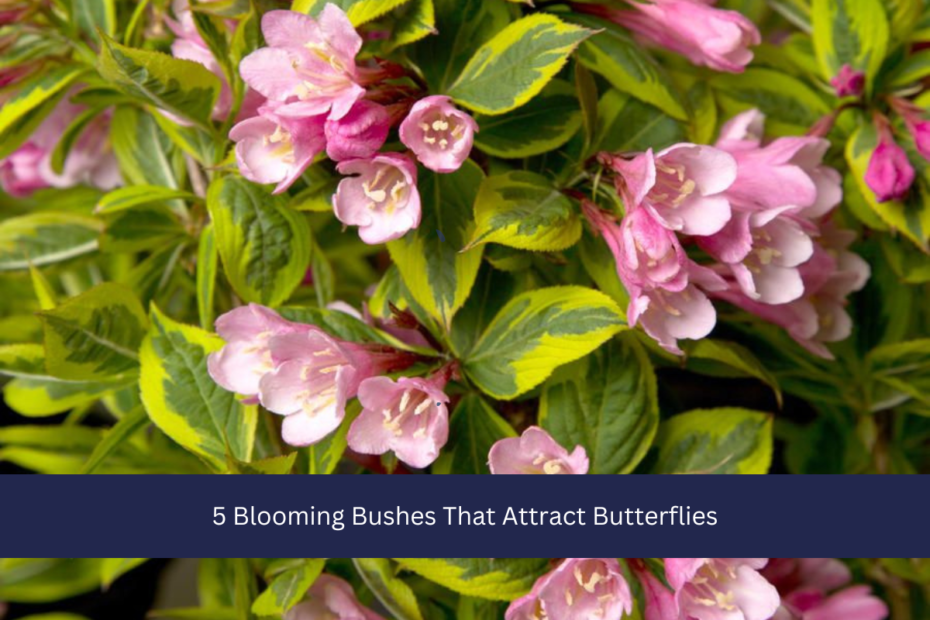5 Blooming Bushes That Attract Butterflies:A garden’s ability to draw butterflies can be greatly enhanced by the selection of blossoming plants. Brightly coloured flowers and blossoms that are rich in nectar attract butterflies. These are five wonderful blooming shrubs that are especially good at drawing in butterflies:
1. Buddleia davidii
The fragrant, long flower spikes of the butterfly bush, sometimes called the Buddleia or Buddleja, are well-known and occur in a range of colours, including purple, pink, white, and blue. Because these blooms contain a lot of nectar, butterflies find them very appealing. Butterflies have an extended period of access to nectar thanks to the summertime blooms of butterfly bushes.
Butterfly bushes want full light and soil that drains properly. Although they don’t require much care, trimming them on a regular basis in the early spring can help them keep their shape and produce more flowers.
They thrive in a variety of soil types, although they require a pH that is slightly acidic to neutral.In addition to drawing butterflies, the butterfly bush also draws bees and hummingbirds, which makes it a wonderful addition to any garden that welcomes wildlife.
2. Syringa vulgaris
Purple, pink, and white hues abound in the fragrant, thick clusters of tiny blooms that make common lilacs so popular. Butterfly attraction to lilac fragrance and nectar is strong.Lilacs provide a burst of colour and smell in late spring and early summer, just in time for butterflies to emerge.
Full sun and well-drained soil are preferred by lilacs. They can survive in a variety of soil types and are fairly resilient, however they prefer slightly alkaline environments. After blooming, pruning can help them keep their shape and increase airflow. Lilacs may give other plants a backdrop of colour and aroma while also adding a pleasant scent to your yard.
3. Monarda didyma,
The brilliant, tubular blossoms of bee balm, often called monarda or bergamot, come in a variety of colours, including red, pink, purple, and white. The plant attracts butterflies, bees, and hummingbirds with its eye-catching blooms that are also abundant in nectar. Bee balm is a perennial flowering plant that yields nectar continuously from mid-summer to early fall.
Bee balm needs moist, well-drained soil and grows best in full sun to partial shade. Because of its susceptibility to powdery mildew, it’s critical to provide enough space for air circulation and to water it properly. Removing spent flower petals can stimulate new blooms.
Bee balm’s fragrant foliage and vivid blooms enliven the garden with colour and scent, and a variety of pollinators are drawn to its nectar.
ALSO SEE:6 Benefits of Turkey Neck Exercises
4. Buddleia x weyeriana, Summer Lilac
This shrub, often called Summer Lilac or Hybrid Butterfly Bush, yields clusters of tubular blooms with hues ranging from lavender to pink to yellow. Summer lilac’s copious nectar attracts butterflies, just as its relative Buddleia davidii.Summertime Lilac blooms prolong the time that butterflies have access to nectar, from midsummer through fall.
Summertime Full sun and well-drained soil are preferred by lilacs. It requires very little upkeep, though annual pruning helps to get rid of dead wood and encourage strong growth. Although it can tolerate a variety of soil types, constant irrigation during dry spells is ideal for its growth.
Summer lilac is a flexible addition to the garden since it can draw hummingbirds and other helpful insects in addition to butterflies.
5. Spiraea japonica
Spirea shrubs have clusters of tiny pink and white blooms, particularly those of the ‘Goldmound’ and ‘Anthony Waterer’ kinds. These blooms add a pop of colour to the yard and are very appealing to butterflies.While certain types give a second flush of blooms in late summer or early fall, spirea usually blooms from late spring until summer.
Spirea grows well in soil that drains well and full sun. Although it is a resilient shrub that needs little maintenance, regular pruning following flowering can help keep it in form and promote new growth. Once established, spiky plants can withstand a fair amount of drought and are tolerant of a variety of soil types.
Spirea is a great addition to mixed borders and butterfly gardens because of its colourful flowers and lovely leaves. It may also be used as a backdrop plant for other flowering plants.
By adding these blooming shrubs to your garden, you may improve the aesthetic appeal and ecological well-being of your outdoor space by creating a colourful, butterfly-friendly habitat.
